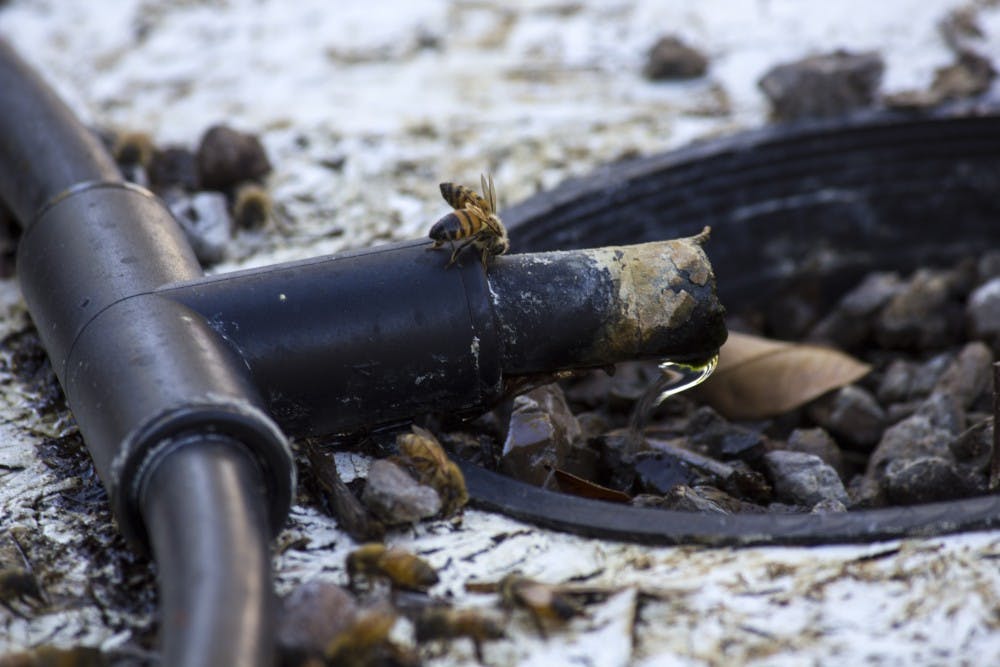Bee populations are declining, but the problem may not be as significant as the public may perceive.
According to the Honey Bee Colonies study published by the USDA, American beekeepers added more bee colonies than they lost in every month of 2015 until June. However, United States beekeepers experienced an 8 percent total loss in colonies between January 2015 and January 2016.
Kevin Brown of Phillips Honey Farms said he believes that the losses cannot be attributed to colony collapse disorder, the phenomenon first documented in 2006 known for causing the failure of bee colonies with little explanation.
CCD has raised concern for declining bee populations because of its mysterious nature, but according to the USDA report only 438,940 bee colonies experienced symptoms of CCD between January 2015 and March 2016.
“Right now, it’s not Colony Collapse Disorder," Brown said. "It’s most likely systemic pesticides, but there’s also mites that have invaded from Europe. So, part of the problem is the mites, but part of the problem is that there are a lot of inexperienced beekeepers now, people that have taken it up, and they’re overmedicating their hives."
Brown didn’t seem phased by the recent decrease. He said bee populations saw an all-time high in 2014.
Despite the 2014 high, honey bee colonies are still dying at high numbers.
Beekeepers with operations of at least five colonies lost 2,151,160 colonies between January 2015 and March 2016 according to the USDA report, but the same beekeepers added 1,877,140 in the same period. This resulted in 2,594,590 colonies in January 2016.
The USDA’s Honey Bee Study is self-reported data from beekeepers and doesn’t include data on what causes the loss of colonies. This makes it difficult for anyone to conclusively say what is causing the deaths of bees.
The study reports that the largest stressor affecting colonies is varroa mites, which Brown said are invading American bee colonies. Colonies seemed to see their highest number of stressors between April and June. During this period, 43.4 percent of national bee colonies had varroa mites, but only 16.6 percent reported being affected by pesticides.
The report shows that 325,010 colonies lost in the U.S. in 2015 showed symptoms of colony collapse disorder.
Joshua O’Rear, bee statistician for the National Agricultural Statistics Service at the USDA, said collecting data on what specifically causes the losses would be hard in a survey style report like the one the USDA publishes.
“When we collect data from beekeepers, we do not query on what actually caused the loss of a colony as that data is difficult to gather without testing honey bees and comb in a lab, something we do not have,” O’Rear said.
This means that there is no hard data on what’s causing the deaths of honey bees, at least not being published by the USDA.
Despite high numbers of varroa mite-affected colonies in Arizona in 2015, there seems to be another factor at play.
In July through September of 2015, Arizona saw very similar numbers of colonies affected by varroa mites, but the number of lost colonies from October to December was nearly double that of the other quarters.
Phoenix beekeeper Scott Clark is skeptical of Brown’s theory of overmedication. He says he has seen beekeepers in the area lose similar numbers of colonies whether they medicate their hives for varroa or not. His explanation for bee colony loss is pesticides.
“When they actually test the hive and the comb, they end up finding a lot of pesticides and herbicides in there," Clark said. "Herbicides can be just as detrimental as pesticides."
Clark also said bees in different areas will fare differently, and that if bees are taken to pollinate crops, they often have a more difficult time surviving.
Because the USDA’s Honey Bee Colonies study doesn't run tests on honey combs and relies solely on self-reported data, it is possible that pesticides could have more of an effect on hives than is being reported.
Despite some differing views, Clark and Phillips both said they thought pesticides could be to blame and voiced concern that the recent application of anti-Zika mosquito treatment could negatively impact bee populations.
There may not be a clear answer on what is killing bees until organizations like the USDA begin testing lost hives, but if beekeepers increase colony numbers to make up for those lost like data shows that they did in the first several months of 2015, bee populations as a whole may remain fairly consistent.
Reach the reporter at cdhenry@asu.edu or follow @carlyhenry_on Twitter.
Like The State Press on Facebook and follow @statepress on Twitter.




